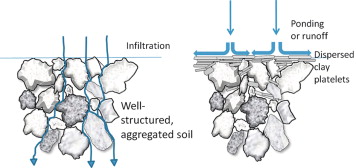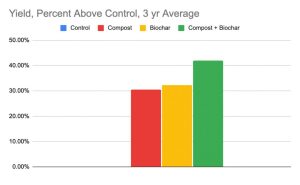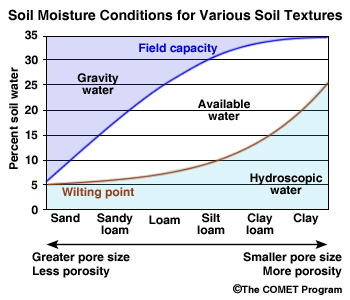Biochar and Water Conservation
By Charlie McIntosh and Josiah Hunt | June, 2022
BIOCHAR AND SOIL ORGANIC MATTER [1, 2, 3, 4, 5]
Biochar is biomass charcoal when used for or found in soil. It is created when plant matter is transformed into charcoal while being exposed to high temperatures with little or no oxygen. It has been a component of soil as long as fire and plants have coexisted. Biomass is an intricately structured material with pores and channels for storing and transporting water and nutrients throughout the growing plant. These physical structures compose most of the complex matrix of large and small pores that give biochar its immense surface area, low bulk density, and unique water holding characteristics. In fertile soils around the world researchers have found soil organic matter (SOM) to contain up to 50% biomass charcoal. These findings demonstrate that biochar has been a natural part of soil formation and soil fertility for millions of years as a long-term stable component of SOM. Research on SOM has consistently demonstrated that higher levels of SOM are directly related to improved soil structure and tilth in all soil textural classes (i.e. coarse, fine, sand, silt, loam) with few exceptions.
BIOCHAR AND SOIL AGGREGATION [6, 7, 8, 9, 10, 11]

One of the ways that biochar and other SOM improves soil structure is through the stabilization of soil aggregates. This occurs by physical, chemical, and biological means that result in improved water retention, infiltration, and percolation. Soil aggregates and aggregate stability influence water’s ability to infiltrate the soil surface during a precipitation event as well as how water percolates through the soil profile. Macro- and micro-aggregates create large and small pores that facilitate the movement of moisture and air into and throughout the soil matrix while providing habitat for soil organisms as well as storage reservoirs for water, oxygen, and nutrients. In coarse textured soils increased aggregation tends to increase water retention while in fine textured soils increased aggregation tends to improve water infiltration and percolation. In all cases, soil aggregation leads to reduced runoff and soil erosion, improving water conservation.

In 2017, researchers at UC Davis applied biochar treatments in a Yolo silt loam and a Vina fine sandy loam to identify the impacts on soil aggregation and soil C stabilization. Their results indicate that biochar can increase soil macroaggregates and reduce losses of soil C, with these effects being pronounced in the fine textured Yolo silt loam. Similarly, a recent meta-analysis published in 2021 by Islam et. al. concluded that while biochar increased soil aggregation in all soil types by an average of 16.4%, the effect was most pronounced in loam and clay soils (i.e. fine textured soils). Wood biochar produced at high pyrolysis temperatures (>650℃) was found to further increase this positive effect when compared with other biochar feedstocks. Researchers also noted that increased soil aggregation was reported more frequently in medium (1-3 year) and long-term (> 3 years) field studies, indicating that biochar’s aggregate stimulating effects are more pronounced as biochar ages in the soil over multiple years after its application.
BIOCHAR AND PLANT AVAILABLE WATER [12, 13, 14, 15, 16, 17]
Biochar can significantly increase plant-available water. Plant-available water (PAW), also called “available water holding capacity”, is a function of a soil’s specific field capacity and wilting point. PAW varies based on soil texture and with SOM content because of varying soil particle size fractions, aggregation, porosity, bulk density, and specific surface interactions that hold water more or less tightly adhered to soil particles. In general, increases in SOM tend to increase PAW by:
- Improving water retention by increasing the soil’s field capacity; observed most often in coarse-textured, “loose”, or excessively-drained soils.
- Improving hydraulic conductivity by reducing the moisture content at wilting point; observed most often in fine-textured, “tight”, or compacted soils.
A recent meta-analysis by Razzaghi et. al. published in 2019 found that biochar additions to coarse-, medium-, and fine-textured soils increased available water by 45%, 21% and 14% respectively, confirming the general trend described above. Studies focused on biochar and hydraulic conductivity have found similar results related to available water with biochar additions resulting in reduced hydraulic conductivity in sandy soils. The mechanism is linked to biochar particles holding more water internally in micropores and thus increasing the water reservoir available to plant roots in coarse textured soils. In clay soils, biochar additions tend to increase the hydraulic conductivity and field capacity simultaneously while also lowering the soil’s bulk density; resulting in improved drainage, porosity, and plant available water.
BIOCHAR AND WATER USE EFFICIENCY [18, 19, 20, 21]
As described in more detail above, where biochar has been applied, soils show improved water retention, infiltration, and/or percolation, however, the specific improvements resulting from a given application of biochar will be dependent on soil textural characteristics. A recently published review article quantified biochar’s agronomic benefits using 26 global meta-analyses, representing more than 1500 scientific articles published between 2016 and 2020. Biochar’s impact on plant available water (PAW) and water use efficiency (WUE) were both found to increase, by 15% and 20% respectively, following additions of biochar when averaged across all soil types and crops. These results and others raise compelling evidence that biochar can significantly increase plant resilience to drought conditions and lead to greater crop productivity per unit of water. These agronomic benefits of adding biochar to agricultural practices for improved water conservation can be seen in different ways:
- Under highly managed irrigation, an expected outcome would be reduction in the amount of water needed to achieve similar crop yield and quality metrics.
 In systems that are limited in control, an expected outcome would be mitigating undesired crop stress due to drought or excess precipitation.
In systems that are limited in control, an expected outcome would be mitigating undesired crop stress due to drought or excess precipitation.
The Oasis Vineyard Trial was funded in 2016 by the California Department of Water Resources (CA-DWR) to study the impacts on water conservation following biochar and compost soil treatments applied pre-planting in a newly established Pinot noir vineyard located in Monterey County, California. All treatments received the same irrigation and fertilization regime. The results from the 6-year trial show that biochar and biochar + compost treatments increased wine grape yield by 32% and 42%, respectively, when averaged over the first 3 harvest seasons. Data collection is on-going, however, these initial results demonstrate improved water use efficiency following a single biochar application. (see the full report on Pacific Biochar website for more details).
BIOCHAR AND DRY-FARMING OR WATER-SAVING (DEFICIT) IRRIGATION [22, 23, 24]
Water conservation practices, such as dry-farming or water-saving deficit irrigation, can be enhanced by additions of biochar. Improvements in water use efficiency allow producers to harvest higher yields and/or plant more acres under water-limited conditions. Genesio et. al. conducted a 4-year field experiment in a non-irrigated vineyard in Tuscany, Italy where biochar-treated blocks demonstrated significantly higher productivity (i.e. yield, average cluster weight, and berry size) without significant differences in grape quality. Yield increases above control were observed to be greatest in years with the least rainfall. Baiamonte et. al. found that biochar additions enabled researchers to reduce the frequency of irrigation under “no water-stress” conditions without a negative impact on crop yields for wheat and sorghum grown in a desert sandy soil; with a lesser, but still significant impact on tomatoes. In the same study, while implementing a deficit irrigation regime (i.e. “water-stress”), the addition of biochar significantly improved water use efficiency in all crops and mitigated yield loss to water-stress. Similarly, Chen et. al. observed a dramatic increase in irrigation water use efficiency for rice production when implementing a water-saving irrigation regime, compared with paddy-field flooding, coupled with a high biochar application rate. These results demonstrate that biochar can help significantly buffer the negative impacts of drought, infrequent irrigation events, and reduced water availability while sustaining much needed crop yields.
biochar
Reference Articles
- Knicker, Heike. (2011). Pyrogenic organic matter in soil: Its origin and occurrence, its chemistry and survival in soil environments. Quaternary International. 243. 251-263. 10.1016/j.quaint.2011.02.037.
- Libohova, Zamir & Seybold, Cathy & Wysocki, D. & Wills, Skye & Schoeneberger, P. & Williams, C. & Lindbo, D. & Stott, D. & Owens, P.R.. (2018). Reevaluating the effects of soil organic matter and other properties on available water-holding capacity using the National Cooperative Soil Survey Characterization Database. Journal of Soil and Water Conservation. 73. 411-421. 10.2489/jswc.73.4.411.
- Huntington, Thomas. (2003). Available Water Capacity and Soil Organic Matter. 10.1201/9780429445552-36.
- Lehmann, J., Kleber, M. The contentious nature of soil organic matter. Nature 528, 60–68 (2015). https://doi.org/10.1038/nature16069
- Rawls, W.J. & Pachepsky, Yakov & Ritchie, J.C. & Sobecki, T.M. & Bloodworth, H.. (2003). Effect of soil carbon on soil water retention. Geoderma. 116. 61-76. 10.1016/S0016-7061(03)00094-6.
- Franzluebbers, A.J. “Water infiltration and soil structure related to organic matter and its stratification with depth” Soil & tillage research 66, no. 2 (2002): 197-205.
- Barthès, B. & Benali, Issam. (2002). Aggregate stability as an indicator of soil susceptibility to runoff and erosion : validation at several levels. CATENA. 47. 133-149. 10.1016/S0341-8162(01)00180-1.
- Wang, D., Fonte, S. J., Parikh, S. J., Six, J., & Scow, K. M. (2017). Biochar additions can enhance soil structure and the physical stabilization of C in aggregates. Geoderma, 303, 110–117. https://doi.org/10.1016/j.geoderma.2017.05.027
- (Figure) Goss, R.M. & Ulery, April. (2013). Edaphology. 10.1016/B978-0-12-409548-9.05143-5.
- (Figure) Lee M-H, Chang E-H, Lee C-H, Chen J-Y, Jien S-H. Effects of Biochar on Soil Aggregation and Distribution of Organic Carbon Fractions in Aggregates. Processes. 2021; 9(8):1431. https://doi.org/10.3390/pr9081431
- Islam, Mahbub & Jiang, Fahui & Guo, Zichun. (2021). Does biochar application improve soil aggregation? A meta-analysis. Soil and Tillage Research. 209. 104926. 10.1016/j.still.2020.104926.
- Razzaghi, Fatemeh & Obour, Peter Bilson & Arthur, Emmanuel. (2020). Does biochar improve soil water retention? A systematic review and meta-analysis. Geoderma. 114055. 10.1016/j.geoderma.2019.114055.
- Glaser, B., Lehmann, J. & Zech, W. Ameliorating physical and chemical properties of highly weathered soils in the tropics with charcoal – a review. Biol Fertil Soils 35, 219–230 (2002). https://doi.org/10.1007/s00374-002-0466-4
- Barnes RT, Gallagher ME, Masiello CA, Liu Z, Dugan B. Biochar-induced changes in soil hydraulic conductivity and dissolved nutrient fluxes constrained by laboratory experiments. PLoS One. 2014 Sep 24;9(9):e108340. doi: 10.1371/journal.pone.0108340. PMID: 25251677; PMCID: PMC4177118.
- Yu O, Raichle B, Sink S. Impact of biochar on the water holding capacity of loamy sand soil. International Journal of Energy and Environmental Engineering 2013, 4:44 http://www.journal-ijeee.com/content/4/1/44
- Li L, Zhang Y-J, Novak A, Yang Y, Wang J. Role of Biochar in Improving Sandy Soil Water Retention and Resilience to Drought. Water. 2021; 13(4):407. https://doi.org/10.3390/w13040407
- (Figure) “The source of this material is the COMET® Website at http://meted.ucar.edu/ of the University Corporation for Atmospheric Research (UCAR), sponsored in part through cooperative agreement(s) with the National Oceanic and Atmospheric Administration (NOAA), U.S. Department of Commerce (DOC). ©1997-2022 University Corporation for Atmospheric Research. All Rights Reserved.”
- Schmidt, H.-P., Kammann, C., Hagemann, N., Leifeld, J., Bucheli, T. D., Sánchez Monedero, M. A., & Cayuela, M. L. (2021). Biochar in agriculture – A systematic review of 26 global meta-analyses. GCB Bioenergy, 13, 1708– 1730. https://doi.org/10.1111/gcbb.12889
- de Melo Carvalho, M. T., de Holanda Nunes Maia, A., Madari, B. E., Bastiaans, L., van Oort, P. A. J., Heinemann, A. B., Soler da Silva, M. A., Petter, F. A., Marimon Jr., B. H., and Meinke, H.: Biochar increases plant-available water in a sandy loam soil under an aerobic rice crop system, Solid Earth, 5, 939–952, https://doi.org/10.5194/se-5-939-2014, 2014.
- Kammann, C.I., Linsel, S., Gößling, J.W. et al. Influence of biochar on drought tolerance of Chenopodium quinoa Willd and on soil–plant relations. Plant Soil 345, 195–210 (2011). https://doi.org/10.1007/s11104-011-0771-5
- Hunt, J. (2022, January 19). Vineyard field trial with biochar and Compost_ 3rd harvest report. Pacific Biochar Benefit Corporation. Retrieved June 8, 2022, from https://pacificbiochar.com/vineyard-field-trial-with-biochar-and-compost_-3rd-harvest-report/
- Baiamonte G, Minacapilli M, Crescimanno G. Effects of Biochar on Irrigation Management and Water Use Efficiency for Three Different Crops in a Desert Sandy Soil. Sustainability. 2020; 12(18):7678. https://doi.org/10.3390/su12187678
- Genesio, L., Miglietta, F., Baronti, S., & Vaccari, F. P. (2015). Biochar increases vineyard productivity without affecting grape quality: Results from a four years field experiment in Tuscany. Agriculture, Ecosystems & Environment, 201, 20-25.
- Chen, X.; Yang, S.; Ding, J.;Jiang, Z.; Sun, X. Effects of Biochar Addition on Rice Growth and Yield under Water-Saving Irrigation. Water 2021, 13, 209. https://doi.org/10.3390/w13020209



